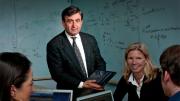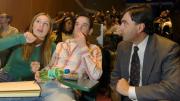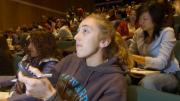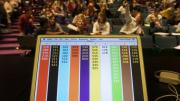In 1990, after seven years of teaching at Harvard, Eric Mazur, now Balkanski professor of physics and applied physics, was delivering clear, polished lectures and demonstrations and getting high student evaluations for his introductory Physics 11 course, populated mainly by premed and engineering students who were successfully solving complicated problems. Then he discovered that his success as a teacher “was a complete illusion, a house of cards.”
The epiphany came via an article in the American Journal of Physics by Arizona State professor David Hestenes. He had devised a very simple test, couched in everyday language, to check students’ understanding of one of the most fundamental concepts of physics—force—and had administered it to thousands of undergraduates in the southwestern United States. Astonishingly, the test showed that their introductory courses had taught them “next to nothing,” says Mazur: “After a semester of physics, they still held the same misconceptions as they had at the beginning of the term.”
The students had improved at handling equations and formulas, he explains, but when it came to understanding “what the real meanings of these things are, they basically reverted to Aristotelian logic—thousands of years back.” For example, they could recite Newton’s Third Law and apply it to numerical problems, but when asked about a real-world event like a collision between a heavy truck and a light car, many firmly declared that the heavy truck exerts a larger force. (Actually, an object’s weight is irrelevant to the force exerted.)
Mazur tried the test on his own students. Right at the start, a warning flag went up when one student raised her hand and asked, “How should I answer these questions—according to what you taught me, or how I usually think about these things?” To Mazur’s consternation, the simple test of conceptual understanding showed that his students had not grasped the basic ideas of his physics course: two-thirds of them were modern Aristotelians. “The students did well on textbook-style problems,” he explains. “They had a bag of tricks, formulas to apply. But that was solving problems by rote. They floundered on the simple word problems, which demanded a real understanding of the concepts behind the formulas.”
Some soul-searching followed. “That was a very discouraging moment,” he says. “Was I not such a good teacher after all? Maybe I have dumb students in my class. There’s something wrong with the test—it’s a trick test! How hard it is to accept that the blame lies with yourself.”
Serendipity provided the breakthrough he needed. Reviewing the test of conceptual understanding, Mazur twice tried to explain one of its questions to the class, but the students remained obstinately confused. “Then I did something I had never done in my teaching career,” he recalls. “I said, ‘Why don’t you discuss it with each other?’” Immediately, the lecture hall was abuzz as 150 students started talking to each other in one-on-one conversations about the puzzling question. “It was complete chaos,” says Mazur. “But within three minutes, they had figured it out. That was very surprising to me—I had just spent 10 minutes trying to explain this. But the class said, ‘OK, We’ve got it, let’s move on.’
“Here’s what happened,” he continues. “First, when one student has the right answer and the other doesn’t, the first one is more likely to convince the second—it’s hard to talk someone into the wrong answer when they have the right one. More important, a fellow student is more likely to reach them than Professor Mazur—and this is the crux of the method. You’re a student and you’ve only recently learned this, so you still know where you got hung up, because it’s not that long ago that you were hung up on that very same thing. Whereas Professor Mazur got hung up on this point when he was 17, and he no longer remembers how difficult it was back then. He has lost the ability to understand what a beginning learner faces.”
This innovative style of learning grew into “peer instruction” or “interactive learning,” a pedagogical method that has spread far beyond physics and taken root on campuses nationally. Last year, Mazur gave nearly 100 lectures on the subject at venues all around the world. (His 1997 book Peer Instruction is a user’s manual; a 2007 DVD, Interactive Teaching, produced by Harvard’s Derek Bok Center for Teaching and Learning, illustrates the method in detail.)
Interactive learning triples students’ gains in knowledge as measured by the kinds of conceptual tests that had once deflated Mazur’s spirits, and by many other assessments as well. It has other salutary effects, like erasing the gender gap between male and female undergraduates. “If you look at incoming scores for our male and female physics students at Harvard, there’s a gap,” Mazur explains. “If you teach a traditional course, the gap just translates up: men gain, women gain, but the gap remains the same. If you teach interactively, both gain more, but the women gain disproportionately more and close the gap.” Though there isn’t yet definitive research on what causes this, Mazur speculates that the verbal and collaborative/collegial nature of peer interactions may enhance the learning environment for women students.
There’s also better retention of knowledge. “In a traditional physics course, two months after taking the final exam, people are back to where they were before taking the course,” Mazur notes. “It’s shocking.” (Concentrators are an exception to this, as subsequent courses reinforce their knowledge base.) Peer-instructed students who’ve actively argued for and explained their understanding of scientific concepts hold onto their knowledge longer. Another benefit is cultivating more scientists. A comparison of intended and actual concentrators in STEM (science, technology, engineering, mathematics) fields indicates that those taught interactively are only half as likely to change to a non-STEM discipline as students in traditional courses.
Scores of Harvard faculty members are experimenting with innovative styles of teaching in their classes. Mazur’s profile is perhaps the highest because he has been at it for two decades and has poured so much passion into the pursuit. But across the University’s faculties, instructors are trying out new, more effective modes of pedagogy, partly in response to a generation of students who have been learning all their lives from computer screens, websites, and visual media (see “Professor Video,” November-December 2009, page 34). Often, these efforts embody a search for alternatives to the traditional lecture. The recent $40-million gift from Rita E. Hauser, L ’58, and Gustave M. Hauser, J.D. ’53, will spur a wide variety of experiments in this realm (see “A Landmark Gift for Learning”).
Such pedagogical invention isn’t just a trial-and-error endeavor. Rigorous evaluations using statistical analysis can help distinguish the most promising innovations. For his part, Mazur has collected reams of data on his students’ results. (He says most scholars, even scientists, rely on anecdotal evidence instead.) End-of-semester course evaluations he dismisses as nothing more than “popularity contests” that ought to be abolished. “There is zero correlation between course evaluations and the amount learned,” he says. “Award-winning teachers with the highest evaluations can produce the same results as teachers who are getting fired.” He asserts that he is “far more interested in learning than teaching,” and envisions a shift from “teaching” to “helping students learn.” The focus moves away from the lectern and toward the physical and imaginative activity of each student in class.
Interactive pedagogy, for example, turns passive, note-taking students into active, de facto teachers who explain their ideas to each other and contend for their points of view. (“The person who learns the most in any classroom,” Mazur declares, “is the teacher.”) Thousands of research studies on learning indicate that “active learning is really at a premium. It’s the most effective thing,” says Terry Aladjem, executive director of the Bok Center and lecturer on social studies. “That means focusing on what students actually do in the classroom, or in some other learning environment. From cognitive science, we hear that learning is a process of moving information from short-term to long-term memory; assessment research has proven that active learning does that best.”
Active learners take new information and apply it, rather than merely taking note of it. Firsthand use of new material develops personal ownership. When subject matter connects directly with students’ experiences, projects, and goals, they care more about the material they seek to master. In the abstract, for example, statistics may seem a dry pursuit, but a graduate student with her own data to analyze for a doctoral dissertation suddenly finds multiple regression a compelling subject.
When Mazur speaks to audiences on pedagogy, he asks his listeners to think about something they are really good at—perhaps some skill they are proud of, especially one that advanced their career. “Now, think of how you became good at it,” he says next. Audience members, supplied with wireless clickers, can choose from several alternatives: trial and error, apprenticeship, lectures, family and friends, practicing. Data from thousands of subjects make “two things stand out,” Mazur says. “The first is that there is a huge spike at practicing—around 60 percent of the people select ‘practicing.’” The other thing is that for many audiences, which often number in the hundreds, “there is absolutely zero percent for lectures. Nobody cites lectures.”
Taking active learning seriously means revamping the entire teaching/learning enterprise—even turning it inside out or upside down. For example, active learning overthrows the “transfer of information” model of instruction, which casts the student as a dry sponge who passively absorbs facts and ideas from a teacher. This model has ruled higher education for 600 years, since the days of the medieval Schoolmen who, in their lectio mode, stood before a room reading a book aloud to the assembly—no questions permitted. The modern version is the lecture.
Though it remains the dominant form of instruction in higher education and can sometimes become a real art form, the lecture may be on its last legs. “The hands-on interactive experience in a lab or an art studio is more powerful than a lecture, and can’t be replicated online,” says Logan McCarty, director of physical sciences education. “The stereotypical lecture where the professor is giving exposition of textbook-type material to the students—I think that type of exposition can be done better with online video or by an interactive-tutorial format.” Today at Harvard, many courses distribute lecture notes, and others post video recordings of lectures online. After hearing about Mazur’s approach to teaching, Weatherhead University Professor Gary King, a government scholar, started to make recorded lectures available before class, thus freeing class time for more active styles of instruction.
The active-learning approach challenges lecturers to re-evaluate what they can accomplish during class that offers the greatest value for students. Mazur cites a quip to the effect that lectures are a way of transferring the instructor’s lecture notes to students’ notebooks without passing through the brains of either. (He also likes a quote from Albert Camus: “Some people talk in their sleep. Lecturers talk while other people sleep.”) “The danger with lucid lectures—of which we have so many on this campus, with so many brilliant people—is that they create the illusion of teaching for teachers, and the illusion of learning for learners,” he says. “Sitting passively and taking notes is just not a way of learning. Yet lectures are 99 percent of how we teach!”
Technology is also pushing lecturers to either get better or explore alternatives. “These days I’m competing, frankly, with myself on video,” said senior lecturer on computer science David Malan at a Faculty of Arts and Sciences program on “Redefining Teaching and Learning in the Twenty-First Century” last February. Online videos of his Computer Science 50 lectures, he said, “are accessible any number of hours of the day, and you can play me at twice the speed and therefore get these lectures twice as efficiently. I genuinely view this as a challenge to myself: what should be the role of lectures in CS 50? It’s definitely an opportunity to present conceptual material, but I also think it’s to incentivize students to get there and stay there throughout the semester: it needs to be a compelling experience.”
At the same time, “More and more faculty are finding that the traditional lecture no longer suits them,” Aladjem notes. “And they are finding alternative ways to connect with students. Some are quite sophisticated in using course websites, blogs, and other means to be in touch. Michael McCormick, Goelet professor of medieval history [see “Who Killed the Men of England?”], holds office hours late at night via Skype, and it’s very popular. Nearly all undergraduates have laptops, smart phones, or other computing devices and use them all constantly. In this environment, we have to keep in mind that there’s some sort of quantum—a fixed amount—of human attention. In a digital age, we are dividing it up into ever-smaller slices, and there’s more and more a race to get pieces of that attention, especially in the classroom. That is one of the biggest challenges facing our faculty.
“I think the answer to this challenge is to rethink the nature of the college course, to consider it as a different kind of animal these days,” he continues. “A course can be a communication across time about a discrete topic, with a different temporal existence than the old doing-the-homework-for-the-lecture routine. Students now tap into a course through different media; they may download materials via its website, and even access a faculty member’s research and bio. It’s a different kind of communication between faculty and students. Websites and laptops have been around for years now, but we haven’t fully thought through how to integrate them with teaching so as to conceive of courses differently.”
Mazur’s reinvention of the course drops the lecture model and deeply engages students in the learning/teaching endeavor. It starts from his view of education as a two-step process: information transfer, and then making sense of and assimilating that information. “In the standard approach, the emphasis in class is on the first, and the second is left to the student on his or her own, outside of the classroom,” he says. “If you think about this rationally, you have to flip that, and put the first one outside the classroom, and the second inside. So I began to ask my students to read my lecture notes before class, and then tell me what questions they have [ordinarily, using the course’s website], and when we meet, we discuss those questions.”
Thus Mazur begins a class with a student-sourced question, then asks students to think the problem through and commit to an answer, which each records using a handheld device (smartphones work fine), and which a central computer statistically compiles, without displaying the overall tally. If between 30 and 70 percent of the class gets the correct answer (Mazur seeks controversy), he moves on to peer instruction. Students find a neighbor with a different answer and make a case for their own response. Each tries to convince the other. During the ensuing chaos, Mazur circulates through the room, eavesdropping on the conversations. He listens especially to incorrect reasoning, so “I can re-sensitize myself to the difficulties beginning learners face.” After two or three minutes, the students vote again, and typically the percentage of correct answers dramatically improves. Then the cycle repeats.
“We want to educate leaders, the innovators of society,” Mazur says. “Let’s turn our students into real problem solvers. In a real-world problem, you know where you want to get, but you don’t know how to get there. For example: how can I bake a cake with no flour? The goal is known, but the prescription to get there isn’t. Most tests and exams at Harvard are not like that; they are questions where you need to determine what the answer is. In physics it might be, What was the velocity of the car before it hit the tree? There, you know exactly what you need to do: you have a prescription to calculate velocity, but you don’t know the velocity. It’s the opposite of a real-life problem, because you know the prescription, but you don’t know the answer.
“Even now, if I give my students a problem on an exam that they have not seen before, there will be complaints: ‘We’ve never done a problem of this kind.’ I tell them, ‘If you had done a problem of this kind, then by definition, this would not be a problem.’ We have to train people to tackle situations they have not encountered before. Most instructors avoid this like the plague, because the students dislike it. Even at Harvard, we tend to keep students in their comfort zone. The first step in developing those skills is stepping into unknown territory.
“It’s not easy. You get a lot of student resistance,” he continues. “You should see some of the vitriolic e-mails I get. The generic complaint is that they have to do all the learning themselves. Rather than lecturing, I’m making them prepare themselves for class—and in class, rather than telling them things, I’m asking them questions. They’d much rather sit there and listen and take notes. Some will say, ‘I didn’t pay $47,000 to learn it all from the textbook. I think you should go over the material from the book, point by point, in class.’ Not realizing that they learn precious little by that, and they should actually be offended if I did that, because it’s an insult to their intelligence—then, I’m essentially reading the book to them.”
In addition to student resistance, there is architectural resistance. “Most classrooms—more like 99.9 percent—on campus are auditoriums,” Mazur says. “They are built with just one purpose: focusing the attention of many on the professor. The professor is active, and the audience is just sitting there, taking in information. Instead, you could get away from the auditorium seating and set up classrooms like you see in elementary schools, where four children sit around a square table facing each other, and you give them some kind of group activity to work on: that’s active learning. It’s no accident that most elementary schools are organized that way. The reason is, that’s how we learn. For some reason we unlearn how to learn as we progress from elementary school through middle school and high school. And in a sense, maybe I’m bringing kindergarten back to college by having people talk to each other!”
“Think of education as a whole—what is it?” Mazur asks. “Is it just the transfer of information? If that’s the case, then Harvard has a problem, and all other universities have a problem, too. Information comes from everywhere now: the university is no longer the gatekeeper of information, as it has been since the Renaissance. And if it were, the only thing we would need to do is videotape the best lectures and put them online, like the Khan Academy [the California-based, nonprofit, online educational organization founded by Salman Khan, M.B.A. ’03]. They have 65 million users: it’s a force to be reckoned with. But ultimately, learning is a social experience. Harvard is Harvard not because of the buildings, not because of the professors, but because of the students interacting with one another.”
Universities are at the core of an information culture: it is hard to imagine any institution that deals more purely in information than higher education. Yet academies are also famously slow to change—both a strength and a vulnerability in a rapidly evolving world. If knowledge now streams in from everywhere, if universities are no longer the “gatekeepers of information,” what essential mission can transcend such technological and cultural change?
“The live classroom is still the best medium for a student to truly be known as an intellectual being and to engage with other such beings,” Aladjem says. “You learn from your peers in all walks of life. Students have always hidden in their rooms; social media can keep them in their rooms longer.” Perhaps the key is to coax students not only out of their rooms, but into each other’s minds. If learning is indeed a social experience, then a “party school”—of a certain kind—just might offer the richest learning environment of all.












